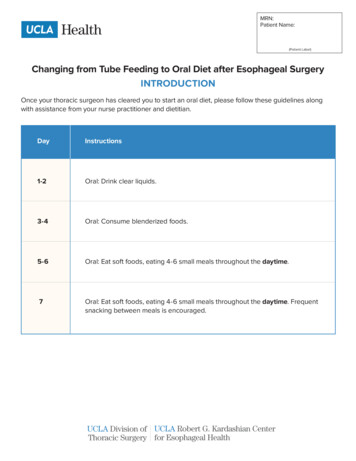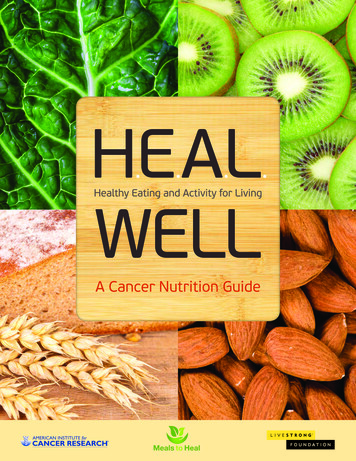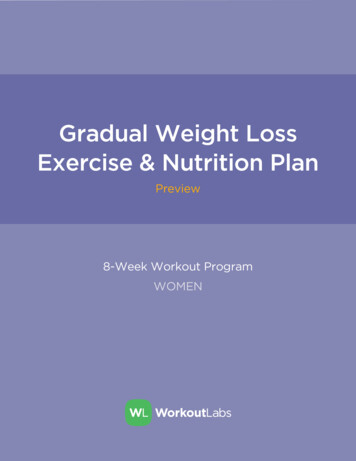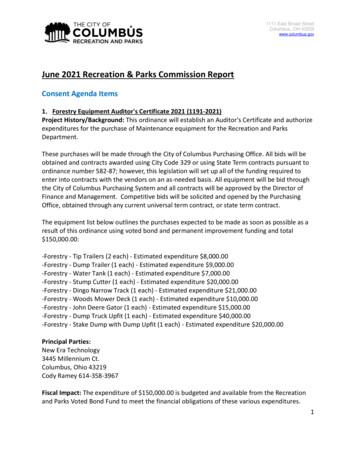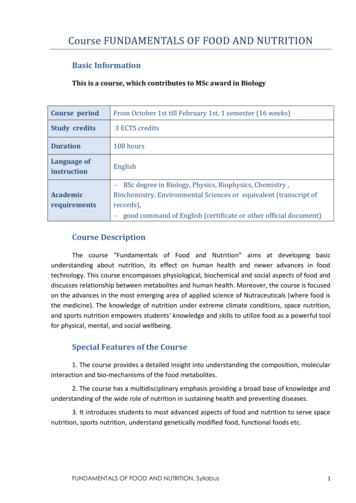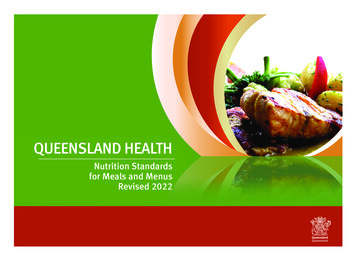
Transcription
QUEENSLAND HEALTHNutrition Standardsfor Meals and MenusRevised 2022220028 Cruickshank Nutrition Standards Feb 17 2022.indd 117/02/2022 1:46:18 PM
Document title:Queensland Health Nutrition Standards for Meals and MenusPublication date:January 2022ISBN:TBCAuthor:Nutrition and Menu Work Group, Statewide FoodservicesAudience:Foodservice personnel and dietitians within Queensland Health facilitiesReview date:2025Endorsed by:Statewide Foodservices NetworkContact:Email: Statewide ese Standards have been prepared to assist menu planning in Queensland Health Facilities to meet patient and client needs.Menu planning shall be a collaborative process and include input from dietitians, foodservice managers and other key stakeholders.This document does not replace or remove local assessment processes that should be considered during menu planning. Information withinthese standards is current at time of publication. State of Queensland (Department of Health) 2012Revised 2015, 2018 and 2022This work is licensed under a Creative Commons Attribution Non Commercial Share Alike 2.5 Australia licence. In essence, you are free to copy and communicate the work in itscurrent form for non commercial purposes, as long as you attribute Queensland Health State wide Foodservices, you distribute any derivative work only under this licence and you abideby the licence terms. To view a copy of this licence, visit: http://creativecommons.org/licenses/by nc sa/2.5/au/.For further information contact Dietitian:Consultant, State wide Foodservices, Department of Nutrition and DieteticsRoyal Brisbane and Women’s Hospital, Butterfield St, Herston QLD 4029Email: Statewide Foodservices@health.qld.gov.auPhone: (07) 3636 2288For permissions beyond the scope of this licence contact:Intellectual Property OfficerQueensland Health, GPO Box 48, Brisbane Qld 4001Email: ip officer@health.qld.gov.auPhone: (07) 3234 1479Originally written by Queensland Health Nutrition Standards Working Party, and first published in 2011.This is version four of Queensland Health’s Nutrition Standards for Meals and Menus, and will remain current until reviewed.Page 2CMM Feb '22 0028 ss220028 Cruickshank Nutrition Standards Feb 17 2022.indd 217/02/2022 1:46:18 PM
CONTENTSForeword. 4Nutrition Standards Working Party. 5Purpose . 6Section 1 – Nutrition Standards .Overarching principle .Adult acute .Adult acute (short stay patients) .Maternity .Paediatrics .Residential aged care .Mental health .Vegetarian and vegan .Therapeutic and medical diets .78910111213141617Section 2 – Meal Component Specifications .Overview .Main (protein) dishes .Soups .Sandwiches .Desserts .Breakfast .Fortification of menu items .Snacks/mid meals .Portion sizes for meal items .18192021212222222324Section 3 – Minimum Menu Choice .How to use the tables .Adult acute .Textured modified (Acute, Residential aged care &Mental health and acquired brain injury).Paediatrics.Residential Care including Aged Care, Mental health andacquired brain injury.252627Section 4 – User guide and definitions .User Guide .Definitions and Abbreviations .References .42434648220028 Cruickshank Nutrition Standards Feb 17 2022.indd 3.Appendix 1 – Length of Stay data . 50Appendix 2 – Reference persons used in Standards Development. 54Appendix 3 – Sample menus . 57313438Page 317/02/2022 1:46:20 PM
FOREWORDIt is my pleasure to present the 3rd revision of the Queensland Health Nutrition Standards for Meals and Menus (Revised 2022). Originally published in 2012, thesestandards have been implemented across Queensland Health and have been used to provide a sound nutritional basis to inform menus and food contracts in ourfacilities.The Queensland Health Nutrition Standards for Meals and Menus provides a framework to enable health facilities to meet the nutritional requirements of patients,residents and clients. They aim to improve the health outcomes and experiences of those in our care by providing both quality meals and appropriate nutrition,reducing the need for costly supplements and extensive dietetic input. In conjunction with the Foodservice Best Practice Guidelines the standards continue to set outoverarching principles that ensure a quality, patient-focused, food and nutrition service.The 3rd revision of the Queensland Health Nutrition Standards for Meals and Menus incorporates feedback and changes for document useability and practicalitywith alignment to new evidence and literature published in the last five years. The document also supports services to meet the National Aged Care Quality Standards(2019).Implementation of these Standards in Queensland Health facilities will not only continue to improve patient, resident, and client satisfaction and outcomes but is alsoa cost-effective way of providing nutrition treatment for malnourished and nutritionally vulnerable people in our care.Shaun Drummond ChiefOperating OfficerQueensland HealthPage 4220028 Cruickshank Nutrition Standards Feb 17 2022.indd 417/02/2022 1:46:21 PM
Nutrition Standards Review 2021, conducted by the NutritionStandards Work Group, Statewide FoodservicesDenise CruickshankLaura BarshaLeisa BromileyStatewide Foodservices, Qld Health (Chair)Mater Health ServicesGold Coast HHSKellie ButlerWide Bay RuralNiccola CurrieTorres & Cape York HHSJulianne DonnellyLogan HospitalJennifer EllickSTARSDr. Mary Hannon-Jones Queensland University of TechnologyCara JohnstoneCairns Hospital & Health ServiceLinda KilworthConsulting Dietitian, Private PracticeTroy LitzowStatewide FoodservicesLiam O’TooleMater Health ServicesAmy MooresLogan HospitalBianca NeavesRoyal Brisbane & Women’s HospitalShelley SmithWest Moreton Hospital & Health ServiceMichelle SuterCaboolture HospitalZoe WalshCOH, MNHHSMelinda WerderRedlands HospitalAcknowledgment of previous Work Groups, 2012, 2015, 2018Laurel EvansGold Coast HospitalDr. Maree FergusonPrincess Alexandra HospitalSara ForbesCairns HHSChristine GugoleEventide Aged CareDr. Mary Hannan-Jones Queensland University of TechnologyAmy HanniganPrincess Alexandra HospitalFiona HjortshojBaillie Henderson Mental Health FacilityMarion HoggIpswich HospitalCassandra HooleStatewide FoodservicesLindsey JohnsonCairns Hospital & Health ServiceWelma JoubertDarling Downs HHSPhillip JuffsRoyal Brisbane & Women’s HospitalLinda KilworthConsulting Dietitian, Private PracticeTroy LitzowStatewide FoodservicesLara McCambridgeThe ParkSally McCrayMater Health ServicesKieran McInnesMackay HHSGai MoritzSunshine Coast HHSBianca NeavesThe Prince Charles/Royal Brisbane HospitalAnneli ReevesLogan HospitalDr. Merrilyn BanksRoyal Brisbane and Women’s HospitalJennifer ShirtcliffToowoomba HospitalTrish CowlishawCentral Qld HHSShelley SmithIpswich Hospital (Chair 2018)Denise CruickshankState-wide FoodservicesTara StevensonQEII HospitalLaura BarshaDietitian, Room Service, Mater Health ServicesMichelle SuterCaboolture Hospital (Chair 2015)Kylie BoycePrincess Alexandra HospitalZoe WalshCISS, MNHHSLeisa BromileyGold Coast HHSDr. Melinda WhiteQld Children’s HospitalKylie BruceThe Park – Centre for Mental HealthLiz WiselyGold Coast HospitalKarly BurtonPrincess Alexandra HospitalKatie VardyGold Coast HospitalJulianne DonnellyRedland Hospital (Chair 2012)/PAH, LoganChristine EadehRoyal Brisbane & Women’s HospitalJennifer EllickRoyal Brisbane & Women’s Hospital/STARSAoife ElliotMater HS/ Qld Children’s HospitalPage 5220028 Cruickshank Nutrition Standards Feb 17 2022.indd 517/02/2022 1:46:21 PM
PURPOSEThe Nutrition Standards for Meals and Menus (NSMM) are designed to providea framework to assist menu planning in hospitals, sub-acute, residentialaged care and mental health facilities managed by Queensland Health (QH).This framework aims to meet the nutritional requirements of the majority ofpatients, residents, consumers and clients taking into account length of stay,age, nutritional status and type of facility. These Standards are designed tobe used in conjunction with the Statewide Food Service KPI1 which informaspects of foodservice provision, menu delivery, type and quality of mealservice and allergen managementin foodservices.The NSMM are intended to be used by dietitians and foodservice managersin the design and assessment of menus and recipes. These Standards providebaseline requirements for general patient and resident menus. However, theydo not replace the need for individual assessment of patients’ nutritionalstatus or needs.This document is presented in four sections as follows:Section 1 outlines:Section 2 outlines: meal component nutrition specifications.Section 3 indicates how these principles are put into practicein a menu including: minimum menu choices required across the day and minimummenu choices required across the cycle.Section 4 outlines: a user guide to assist with menu review process; and definitions used throughout the document.These standards are based on the premise that patients in QH hospitalsand residential aged care homes are predominantly unwell or frail andhave different nutritional requirements to the general public. The FoodModelling System Foundation and Total Diets2 are not applicable as theserecommendations aim to meet the nutritional needs of healthy populations.However, increasing numbers of aged care residents and short stay acutepatients are overweight or obese and mental health consumers are generallyyounger, tend to have longer lengths of stay3,4 and are known to experienceincreased rates of chronic disease.5,6A preventative health approach is warranted in menu design and choices inaddition to traditional higher energy and protein options for these groups,and as such, the National Health and Medical Research Council’s NutrientReference Values7 recommendations for chronic disease prevention and TheAustralia Dietary Guidelines 20132 were considered in the development of thesection outlining choices for menus to residential facilities including mentalhealth and aged care consumers and some of the menu options for acutepatients, particularly the short stay cohort.Page 6220028 Cruickshank Nutrition Standards Feb 17 2022.indd 617/02/2022 1:46:21 PM
SECTION 1NUTRITION STANDARDSNutrition Standards for Meals and Menus220028 Cruickshank Nutrition Standards Feb 17 2022.indd 717/02/2022 1:46:25 PM
NUTRITION Standards1.0OVERARCHING PRINCIPLEAim:Food provision shall meet the nutritional requirements of the majority of patients, residents, consumers and clients, taking into account age, clinical need,nutritional status, psychosocial needs, cultural and religious diversity and length of stay.BACKGROUND/RATIONALESTANDARDSPatients in hospital are usually acutely ill or suffering from chronic diseases andthis increases their nutritional risk. There is significant evidence that poor oralintake in addition to clinical treatment or medical disease is responsible for poornutritional status of patients in hospital.8,9,10,111.1Menu planning will be undertaken as a collaborative process and willinclude dietitians, foodservice managers and other key stakeholders toensure nutrition, financial, psychosocial, choice and quality goals are met.1.2An accredited practising dietitian (as per DA)# will be available to assessthe food and menu as meeting these NSMM and the requirements(cultural, religious, age, psychosocial, nutritional status) of thepopulation in the facility.171.3The menu is reviewed by an accredited practicing dietitian biennially.11.4Patients/residents/clients are able to access at a minimum, three mainmeals and three mid-meals each day.11.5Serve size variations* are offered on the menu.The literature suports a link between poor nutrition status, recovery fromillness, increased complications, length of hospital stay and increasedcosts.12,13,14 Recent evidence suggests that a systems-level approach throughimplementation of multidisciplinary, system-level interventions may be moreefficient and cost effective in reducing hospital acquired malnutrition, comparedwith existing dietetic care.15 The literature also supports that identifyingnutritionally at-risk patients or residents and implementing appropriatenutritional support, can present cost savings through reduced length of stayand health complications.161.6The Statewide Food Service Key Performance Indicators1 and Best PracticeGuidelines17 have been developed to ensure a client focus and should be used in1.7conjunction with these standards.This overarching principal applies to the patient groups included inSections 2.0 – 9.0: Adults – Acute, Maternity, Paediatrics, Residential AgedCare, Mental Health and Acquired Brain Injury, Vegetarian and Vegan and thoseon Therapeutic and Medical Diets.The facility will endeavour to accommodate cultural and religious foodpreferences within the restrictions and constraints of food supply issues.The facility will endeavour to meet the patients/clients/resident’snutritional requirements through the provision of nourishing foods.Oral nutrition supplements should not be used as a substitute for foodunless clinically indicated.18Note: *Refer to pp 47 for definitions on serve sizes#Dietitians Australia, Accredited Practising Dietitian Program. www.dietitiansaustralia.org.auPage 8220028 Cruickshank Nutrition Standards Feb 17 2022.indd 817/02/2022 1:46:25 PM
2.0ADULT: ACUTE (EXCLUDING SHORT STAY PATIENTS)Aim:The food offered provides choice, variety and meets the nutritional needs of the majority of patients, including those with higher proteinand energy nt of length of stay (LOS) in 2011 and 2014 at seven and two QH2.1 Adult facilities shall have systems in place to identify patients who arehospitals respectively, indicated that 60% – 75% of occupied bed days (OBD)at nutritional risk or are malnourished.23are patients staying longer than seven days where these patients had an average2.2 The long stay menu shall provide a minimum choice across cycle lengthLOS of 14.7 to 22.4 days (refer to Appendix 1 p 50). Reassessment of 7 sites inof 35 hot main meals with choices as outlined in Section 3 Minimum2018 identified that 27 – 60% of OBD are patients staying longer than sevenMenu Choice (p 27 – 30).days with an average LOS of 17 days.2.3 The long stay menu shall provide the opportunity to choose three mainThe literature also supports that identifying nutritionally at-risk patients ormeals and three mid-meals each day. At least two mid meals areresidents and implementing appropriate nutritional support, can present costsubstantial i.e. group 1 or 2 (refer to Meal Component Table p 27).savings through reduced length of stay and health complications.162.4 The long stay menu shall provide fortified options for:Patients assessed with or at risk of malnutrition, or who are admitted for more hot cereal;than seven days in acute facilities, need access to extra food choices and higher soup;energy/protein options at meals and mid-meals. This will increase the likelihoodFortified foods will meet the nutrition targets outlined in Section 2of meeting nutritional and psychosocial needs.Meal Component Specifications (p 19 – 23).Studies measuring the effects of providing energy dense meals and snacks tohospitalised patients19,20,21,22 reported an increase in energy and protein intakewhen fortified food was provided. One study21 that looked at fortification of foodfound a cooked breakfast resulted in the highest increase in energy and proteinintake.2.5The long stay menu shall provide a hot protein breakfast choice for alltexture levels, including full, easy to chew, minced & moist and pureed.(refer to Definition – Breakfast Protein p 46 and Meal Component Tablep 22).Page 9220028 Cruickshank Nutrition Standards Feb 17 2022.indd 917/02/2022 1:46:25 PM
3.0ADULT: ACUTE (SHORT STAY PATIENTS)Aim:An additional menu may be provided for patients staying less than seven days. The menu offered shall meet average requirements for protein and energyfor the patient group.BACKGROUND/RATIONALESTANDARDSPatients who are in hospital less than seven days are considered short stay.These individuals, if not assessed as being at nutritional risk, do not requireextensive choice on the menu or high energy/high protein options at allmid-meals.3.1An alternative menu for short stay patients (LOS less than seven days)shall have minimum choices across the menu cycle as outlined inTable 1.0 Adult Acute Minimum Choice (p 27 30) to meet theaverage requirement for non-nutritionally compromised adults.Nutrition screening will be carried out to identify those patients at risk andneeding the long stay menu.23Assessment of LOS at seven QH hospitals indicated that between 81 to 95%of patients admitted to these hospitals stay less than seven days (refer toAppendix 1 p 50 51 for detailed LOS data and analysis). Assessment ofproportional LOS at these seven sites in 2018 indicated that approximately50% of OBD are patients staying longer than seven days with an average LOSof 17 days.A short stay menu (refer to p 47 for definition) provides an opportunity tooffset any potential increased costs associated with the long stay menu. In thisinstance the long stay menu is intended to be targeted to patients/residentsthat have the highest nutritional needs.Page 10220028 Cruickshank Nutrition Standards Feb 17 2022.indd 1017/02/2022 1:46:25 PM
4.0MATERNITYAim:The food provided shall meet the majority of nutritional requirements of pregnant and breastfeeding women.BACKGROUND/RATIONALESTANDARDSDuring pregnancy there are increased nutritional requirements.25,26 Nutrients can 4.1generally be met with a normal healthy diet as provided by the long stay menu.However elevated iron, iodine and folate requirements need consideration inmenu planning. Dietary supplementation of iodine27 and folate7,25 are requiredduring pregnancy, and for iodine to be continued during breastfeeding.274.2Sufficient choice should be provided to allow appropriate options for patientswho are overweight, obese or have gestational diabetes. Breastfeeding womenhave increased energy and fluid requirements, thus require access to additionalfood and fluid choices.74.3Pregnant and breastfeeding women shall be provided with the long staymenu (refer to Standard 2.0 Adult: Acute (p 9) in acute facilities toassist in meeting the increased energy, protein and micro nutrientrequirements.Pregnant women shall be provided access to fresh water, sufficientsnacks and other fluids.Pregnant women shall be provided with access to nutritional supplements(as assessed by a dietitian) if required.Where dietary intake is compromised due to hyperemesis gravidarum orother complications, a therapeutic diet and/or nutritional supplement(s)may be required.Pregnant women and their unborn child are considered at high risk of listeriosis.Current Food Standards Australia and New Zealand (FSANZ) recommendationsoutline pregnant women should take care with their food choices.29,30 Facilityfood safety programs should identify and mitigate listeria risks for maternitypatients.Page 11220028 Cruickshank Nutrition Standards Feb 17 2022.indd 1117/02/2022 1:46:25 PM
5.0PAEDIATRICSAim:The food provided shall meet the nutritional requirements for the majority of children, and are appropriate for age and development.BACKGROUND/RATIONALESTANDARDSNutrition Standards are designed to provide a guideline for menus for childrenover 12 months. Children under 12 months will have their nutritional needs metby a combination of food and breastmilk or formula.31 Under 12 months, infantfood needs are dependent on the stage of weaning and extent of breast or bottlefeeding and will need to be individually assessed or guided by the carer. Solidfoods are usually introduced at around six months and not before four monthsof age.32 While transitioning to family meals, infants require suitable texturemodified foods including puree, mashed, cut up and finger foods. For moreinformation on infant feeding please refer to the “Baby’s first foods” resource onQueensland Health Nutrition Education Materials Online.335.1Paediatric patients in an acute facility shall have access to a menu with 35hot meal choices across the menu cycle and choices equivalent to thoseoutlined in Table 2 Paediatric Minimum Menu Choice (p 34 – 37).5.2Choices shall be available for children requiring therapeutic dietseg. cystic fibrosis, gluten free.5.3All paediatric menus shall be free of whole nuts and nut pasteswhere possible.5.4Choices shall be available for children with food allergiesand intolerances.LOS data (2018) supports that 40% of bed days are children who stay less than5.5seven days. 60% of bed days are children who stay longer than seven days andhave an average LOS of 17.5 days (refer to detailed LOS data in Appendix 1 p 51).5.6A 2014 study on malnutrition, obesity and nutritional risk of Australianpaediatric patients found that 15% of Australian paediatric inpatients aremalnourished and 5.5% experience severe malnutrition. 18.7% of patientswere overweight or obese.34 Therefore, it is important for paediatric menusto be flexible to meet a wide scope of requirements across all age ranges. Toencourage children to eat sufficient food to meet their nutritional requirements,meal choices should be child friendly, nutritious and appealing with a balancebetween healthy options and familiar or favourite meals.35Choices for suitable weaning foods with appropriate textures shallbe available for infants weaning onto a solid food diet.Honey shall not be given to infants under the age of 12 months due to therisk of botulism.36Adolescents in paediatric facilities or units will sometimes require largerservings or the adult acute long stay menu.Page 12220028 Cruickshank Nutrition Standards Feb 17 2022.indd 1217/02/2022 1:46:25 PM
6.0RESIDENTIAL AGED CAREAim:Both the food and dining environment should meet the nutritional and psychosocial needs of residents including those with higher protein/energyrequirements and those requiring texture modified meals, whilst providing choice and variety.BACKGROUND/RATIONALESTANDARDSEach consumer is supported to exercise choice and independence with regard totheir food and meal choices. 37 Menus offered will have adequate variety, quality andquantity in accordance with residents’ individual nutrition needs including specialdietary, medical, religious or cultural requirements.38, 396.1Residents in aged care homes shall receive a menu with a cycle of noless than 14 days and minimum choices across the menu cycle equivalentto those outlined in Table 3 Residential Aged Care Minimum Menu Choice(p 38-41).Recommended dietary intakes per day of Vitamin B2, B6, D, calcium and proteinincrease with ageing.40 Providing adequate omega 3 fats has been shown to benefitcognitive ability in elderly populations.41, 426.2A hot and cold protein breakfast choice shall be offered to residentson full and easy to chew textured diets each day. A fortified hot cerealwill be available every day.Older adults have higher protein requirements ( 1.2g/kg/d) to help minimiseage-related sarcopenia, a common condition contributed to by anabolic resistance,sedentary lifestyle and common illnesses.43, 44 There is evidence to suggest thatoptimum protein synthesis is approximately 30g per meal, and therefore to meet dailyrequirements, consumption should be spread equally across three main meals.44, 45,466.3A hot protein breakfast choice shall be offered to all residents on mincedand moist and pureed diets each day.Elderly persons are at risk of inadequate dietary intake, including but not limited to,chewing/swallowing difficulties, dementia, changes to metabolism and other commonillnesses. With most nutrient requirements being similar or higher in ageing and totalenergy (kilojoules) targets being lowered compared to younger adults – all residentsshould be assessed on admission and reviewed as necessary by the Dietitian.39, 46Choice and variety of texture modified diets through food fortification and fingerfoods (refer to p 46 for finger food definition) are all highly desirable.38, 47, 48 These canfacilitate increased oral intake, independence and self feeding. 39, 49, 506.5 Additional food and/or fluid supplements shall be available as requiredincluding accessible snack options any time of the day and night.The use of moulded pureed and minced & moist texture modified meals improvesvisual presentation, food recognition and intake74.6.8 Use moulded puree and minced & moist texture modified meals wherepossible.A study that measured the effects of providing energy dense meals and snacks tothe institutionalised elderly48 reported an increase in both energy and protein intakewhen fortified food was provided. Another study21 also looked at fortification of foodand found a cooked breakfast resulted in the highest increase to energy and proteinintake.6.9Constipation and dehydration are also common issues in elderly persons for variousreasons, thus encouraging appropriate food and fluid intake will be beneficial.416.11 The menu shall aim to provide 25-35g/d of fibre from a variety of sources.41An increase in the incidence of overweight and obese residents in residential agedcare has been evident over recent years necessitating the availability of healthiermenu options with a goal of maintaining weight while increasing lean body mass.51, 526.4 Protein options shall be offered at all 3 main meals to ensure adequateconsumption per meal-time can be achieved.6.6 Finger food options shall be available when required for those residentswho are identified as benefiting from them.6.7 The menu shall provide fortified options for hot cereal and soup for fulland texture modified diets. Fortified foods will meet the nutrition targetsoutlines in Section 2 Meal Components (pp19 - 23)High protein, lower energy options shall be available for residentsrequiring weight management.6.10 Fish as a rich source of omega 3s shall be offered at least 3 times a weekon the menu either in hot meals, salads or sandwiches.6.12 Residents shall have the opportunity to have input into menu choicesand menu reviews. If residents are unable to have input, familymembers can be consulted on preferred menu choices or for inputinto menu reviews.Page 13220028 Cruickshank Nutrition Standards Feb 17 2022.indd 1317/02/2022 1:46:25 PM
7.0MENTAL HEALTHAim:The food provided shall meet the psychosocial, nutritional and physical health needs of consumers and support healthy choices with a focus on chronicdisease prevention and management.BACKGROUND/RATIONALESTANDARDSMental health and acquired brain injury consumers represent a diverse patientpopulation, whose longer length of stay is one important factor in determiningtheir nutritional requirements. Individuals with severe mental illness experiencedouble the rates of obesity compared to the general population and are atsignificantly higher risk of chronic disease, including: cardiovascular disease,type 2 diabetes and associated risk factors such as dyslipidaemia andhypertension.5, 6 These diet-related disorders are the primary cause of morbidityand mortality in this population who experience a 13-25 year shortened lifeexpectancy.57.1In mental health and acquired brain injury settings the menu shall consistof a minimum cycle length of 14 days with choices equivalent to thoseoutlined in Table 4 Mental Health and Acquired Brain Injury MinimumMenu Choice (p 38-41).7.2Facilities shall have systems in place to identify consumers who are atnutritional risk or are malnourished.7.3Where practicable options shall be available for consumers
Page 4 FOREWORD The health outcomes and experience of those in our care can be improved with quality meals and good nutrition. The Queensland Health Nutrition Standards for Meals and Menus supports this by providing a framework to enable health facilities to meet the nutritional require
